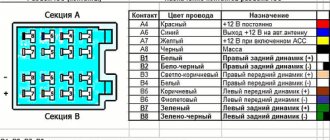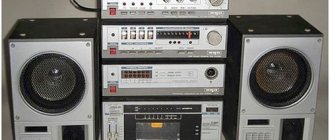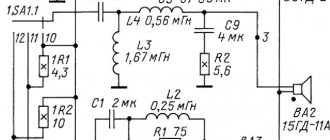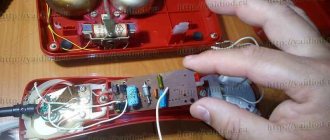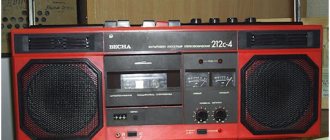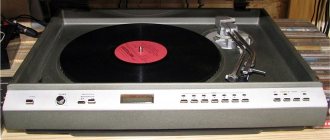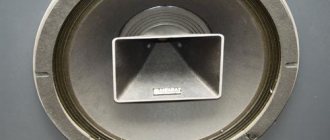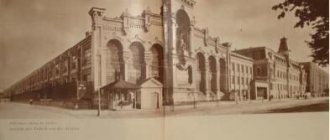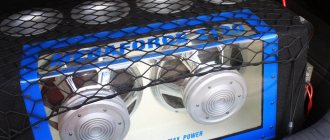Author: serge80
03 August 2014 09:54
Tags: Nakamichi audio tape recorders
9835
13
6
Nakamichi is a Japanese company founded in 1948. From 1973 to 1993, Nakamichi, under the leadership of brothers, radio engineers Etsuro and Niro Nakamichi, became a leading designer and manufacturer of exemplary cassette decks.
0
See all photos in the gallery
Where are the roots of Nakamichi's tradition and why is corporate philosophy fundamental to all products bearing the Nakamichi logo? This is our story.
The beginning of the journey The history of Nakamichi began in 1948, when a group of enthusiastic engineers, passionate about research in the field of acoustics and electronics, founded a research and development company. Yetsuro Nakamichi dreamed of bringing together the best engineers and scientists to work on improving existing technologies and creating world-class audio and communications equipment. The new company was named Nakamichi Research and in its early years was engaged in basic research and development in optical and magnetic technologies. Few of Nakamichi's competitors could say that they have been in the hi-fi industry for over 50 years!
0
The history of the manufacturer of hi-fi components began with photographic accessories. Professional photographers still use Nakamichi's invention of this period - the Seconic light meter (luxmeter). This instrument uses the photoelectric principle to measure the intensity of visible light. In 1957, a proprietary magnetic head for cassette recorders was developed. From the very beginning, Nakamichi strived to get the most out of this recording format. The use of special materials and design made it possible to obtain a wide reproduction range - from 20Hz to 20kHz.
0
The magnetic head is the beginning of a long journey. Nakamichi's first household devices were reel-to-reel tape recorders of the type that was typical for the audio industry of the 50s and 60s. These were open-reel tape recorders, produced, like most Japanese equipment of that time, as OEM equipment for more well-known brands (Magic Tone, Harmon Kardon, KLH, Advent, Fisher, ELAC, Sylvania, Concord, Ampex, Motorola, etc. ). At that time, the OEM market was a fiercely competitive arena. To succeed, it was necessary not only to offer the most attractive prices to the brand-owning companies involved in wholesale purchasing. It was also important to maintain product quality at the proper level so that these market operators could minimize their warranty costs. Working under these challenging conditions, Nakamichi has learned to achieve optimal production efficiency while offering high quality at a reasonable price.
0
Compact Cassette In the early 1960s, Phillips Electronics introduced a new magnetic tape-based audio media format that became the most popular in the history of the audio industry - a small two-reel cartridge called the Compact Cassette. This medium combined such advantages as protection from external influences, compactness and a fairly long playback time. Very soon the compact cassette became the most popular portable recording and playback format.
At first, manufacturers were faced with the task of creating a cassette with stereo recording... However, if we consider the compact cassette as a potential carrier of information with high quality playback, then several shortcomings can be noted in its design. Since it was originally intended to be used exclusively for "live" voice recording, the magnetic tape moved through it at a very low speed, about 1/4 of the recording speed of most open-reel tape recorders. The magnetic tape in the cassette was twice as narrow as that used in reel-to-reel tape recorders, so two-track recording seemed to be a difficult task. The biggest problem, however, was the tape winding mechanism built into the cassette itself. Cassette deck designers had to take into account the accuracy limitations imposed by cheap, mass-produced storage media. In short, the compact cassette did not promise much promise in the field of high-precision music recording, as many experts of the time stated.
0
Improvements in cassette deck design By the late 1960s, Nakamichi was actively engaged in the private production of high-quality cassette decks, sold under other brand names. But the company was not completely satisfied with its achievements. She believed that, despite its obvious shortcomings, the compact cassette could be turned into a truly high-quality carrier of musical information. Engineering solutions were required that would help overcome the shortcomings of its design. A research program was launched to study methods for reducing magnetic tape noise. This program ran in parallel with research by Dolby Laboratories and KLH.
The first result was the release of a household reel-to-reel tape recorder with high fidelity recording and playback. It used a simplified version of the Dolby noise reduction system based on complex compression/decompression of the audio signal, as well as the best magnetic heads and tape mechanism that Nakamichi engineers were capable of. Nakamichi's research work received license #1 to use the new Dolby-B noise reduction system. In 1969, the company presented the result of its research - the KLH41 cassette recorder. Nakamichi engineers soon used similar technologies and components to develop the world's first cassette deck with Dolby noise reduction and high bias current settings. This model was launched on the market under the Advent brand. Over the next three years, Nakamichi technology dominated the field of cassette magnetic recording, although the company itself remained in the shadows. In 1972, testing by Consumer Report magazine found that cassette decks made by Nakamichi (but sold under other brands) ranked 1st, 2nd, 5th and 7th for best performance.
0
The first product released under its own brand Despite all the achievements of Nakamichi, its products were still marketed under other brands. It's time to change this situation. For over a year, Nakamichi engineers and developers worked on a cassette deck design that would solve all the major problems associated with cassettes, while still providing the same sound quality as reel-to-reel tape recorders. In 1973, such a deck was finally created. First there were drawings...
0
For those outside the audio industry in the 1970s, it's hard to truly appreciate the significance of the Nakamichi 1000. Using analogies, this soundboard combined the novelty of the Lamborgini Diablo with the conceptual grandeur of the first Porsche 928. It was the most expensive cassette deck in the world, and also the largest in size and the number of parts and complex technologies used. …then production of tape transport mechanisms for third-party manufacturers
0
But the most important thing was that this deck was literally replete with features never before seen in cassette recorders - from three read heads to fully electronic control of the tape mechanism, azimuth adjustment of the magnetic head and peak signal meters. This deck was immediately recognized as the most significant audio electronics product in history. It had a fundamental impact on the further development of the entire hi-fi industry. In 1982, the Nakamichi Dragon cassette deck set a new performance standard for this type of device and became the recognized standard for quality home recording and playback. It is interesting that, although the design of this deck was developed 9 years after the release of the 1000 model, it, in fact, continued to improve the solution to the same problems that were formulated at that time. Nakamichi engineers used a new azimuth automatic adjustment system for the magnetic head, NAAC (Nakamichi Auto Azimuth Correction), in the Dragon model. The operating capabilities of the deck have been significantly expanded, to which a convenient auto-reverse function has been added. legendary Nakamichi-1000
Nakamichi RX-202 autoreverse
In 1983, another method was proposed to overcome the skew of the magnetic head, which often occurs during auto-reverse playback - the UDAR (Uni-Directional Auto-Reverse) system. The UDAR system, developed for the RX series cassette decks, physically reversed the cassette in order to completely eliminate the possibility of such misalignment. UDAR technology mechanically reversed the cassette
0
In 1983, Nakamichi introduced a line of car audio equipment, the flagship model of which was the TD-1200 car radio. It featured a completely new design using dual drive shafts, large flywheels, a constant speed motor, and NAAC (Nakamichi Auto Azimuth Control) technology—exactly the same technology as the Dragon home cassette deck. This car radio was soon recognized as the best car cassette player in the world. The beginning of the 80s - the time of cassette car audio
0
In 1990, the first line of CD changers with the MusicBank mechanism debuted. This amazing mechanism loads CDs through a single slot, requiring no cartridge or tray, and prevents damage to the CD's delicate surface. The MusicBank mechanism is still used in audiophile-quality CD players, computer CD-ROM drives, and even car stereos. In 1991, a line of audio components was created that have earned the reputation of being the most “musical” on the market. Nakamichi has confirmed its reputation as a company producing prestigious and exclusive equipment with the highest sound quality. From 1990 to this day, Nakamichi Corporation has been a prestigious brand in the world of Car Audio
0
1993-95 marked the end of the compact cassette era. The Nakamichi Corporation, along with other manufacturers in the industry, entered a period of crisis. After analyzing the current situation, Nakamichi decided to change its strategic guidelines and enter the promising segment of integrated designer home theaters and stereo systems. In 1995, the company became involved in the development of home theaters
0
In 1998, Nakamichi introduced a new line of audio equipment, SoundSpace. This innovative product combined the precision electronics that made Nakamichi world famous with exceptionally stylish design. The SoundSpace series was built on Nakamichi's previously developed and proven hi-fi electronics components, featuring a brushed aluminum finish, motorized disc receivers, and unusual parts layout. Developed in 1998, the SoundSpace line exudes high-tech aesthetics. All SoundSpace products look like works of art, whether they're mounted on a shelf or mounted on a wall like a stylish painting. But what makes this series truly unique is that it is first and foremost based on the exceptional quality and precision of the electronics, which are then given an impressive appearance. Other companies trying to produce products that seem similar at first glance do the opposite - first they develop an original case, and then stuff it with transistors and resistors so that it can make some sounds. For Nakamichi, music has always been and remains first.
0
Devotion to Music The year 1977 marked another milestone in Nakamichi's history. A private music center was built - the Nakamichi Concert Hall, equipped with an organ, piano and harpsichord. It seats 102 people and is used to study the acoustic environment of live music performances under controlled sound propagation conditions. This concert hall has a recording studio located directly above the stage, equipped with Nakamichi recording equipment and various electronic devices. In another part of this center is a carefully designed listening room that allows direct comparison of live and recorded sound. This is how Nakamichi's idea of creating an absolute acoustic standard was realized.
Nakamichi's dedication to music has also been demonstrated in other ways: back in 1982, the late Yetsuro Nakamichi founded a charitable organization in memory of his love of music, the E. Nakamichi Foundation. This foundation sponsors concerts and music competitions, provides grants and funds cultural exchange, supporting professional and amateur musicians approaching professional levels of excellence. This is exactly the rare case when a hi-fi equipment manufacturing company devotes its activities not only to playing music, but also to creating it.
Nakamichi CD-700 II
Nakamichi CD-700 took place at AvtoZvuk in 2000. Over the past six years, the model has undergone only one change: the tuner received an RDS decoder.
This is the only one of the participants in today's test whose built-in amplifiers do not turn off, because there are none, that is, this is not a CD receiver, but a CD tuner. All adjustments are made by potentiometers, for the most part (except volume) with an indispensable fixed midpoint. With this design, it is almost impossible to make the front panel removable, just as it is impossible to organize wireless remote control (if you do not take the option with a servomotor). The tone/balance control knobs are retractable, two of them even have two working positions: the first controls the tone (Bass or Mid), the second controls the fader or balance. The third timbre (Hi) has only one operating position. You can bypass the tone and balance controls; the display will display the following message: “TONE OFF (BAL OFF).” The fader control remains “in use” in any mode. The display is very small and archaic, but the fact is that with such a control organization there is no need to receive information from the display - what you are currently controlling is clear. Unfortunately, there is no dimmer, but the compact LCD display will definitely not interfere at night, and even during the day, in not very bright light, it is quite readable thanks to the high contrast of the characters. The tone knobs, of course, are not amazingly ergonomic, but according to the concept that underlies the device, they should be used as rarely as possible. The buttons on the top row are extremely easy to use, and only the lack of a remote control prevented us from giving the Nakamichi a higher rating for ergonomics. The interface is not at all as minimalist as one might expect. Three pairs of line outputs (one of which is non-fader outputs) are complemented by a digital output. Therefore, if you really want, you can select and connect an external processor to the CD-700, but for the integrity of the concept, I would advise doing without digital conversions, using only analog filters and an equalizer. The input from the changer (it is separated from the control bus), as well as from an external device (Aux), is implemented both analogue and digital. Of course, it's tempting to connect an external source to an audiophile-grade 24-bit DAC, but most modern digital devices (except CD changers) don't want to deal with PCM code.
The AM tuner only works on medium waves, but it is provided with two memory banks. Manual tuning is only step-by-step; there is no automatic bank filling mode, which means that the tuner does without a processor in the usual sense. There is no program standby mode in RDS; there is a CT function, although for some reason we were unable to synchronize the clock.
The CD player is free from “innovations” such as reading CD text. The loading mechanism operates deliberately loudly, as if not hiding its activity: here the disk is lowered onto the spindle, rather than the drive “pulling up” under the disk, as happens most often. The loading process lasts 3 seconds, and the CD tuner takes 5 seconds to prepare for playback. The head positioner is, as expected, quiet - it doesn’t need to make noise. The tracks do not switch in a ring, which is very rare these days. Of course, there are no compressed format decoders here: at the time of development of this product there were no standards for them.
The rare transparency of the sound of male voices is combined with some softness. I’ll tell you for sure: no previous participant had such a combination. Yes, there are a lot of sibilants, but they are not even digital. Female vocals sometimes seem sharp, but it is not possible to isolate any specific sign of this sharpness. Apparently, it's all about unusual openness. The violins are perfect - my homemade, carefully selected “siduk” conveys them not so clearly. The maracas seem sharp at first, but the ballet “Don Quixote” (live) emerges from the depths of memory - this is how they should sound. The top, in short, is in perfect order, only unusually open. There are no complaints about the bass either. Then it begins: listen to how “Nak” plays this track, and how to play that one. This is no longer for work, but for yourself. What an atmosphere! That is, a set of subtle surrounding overtones that create it. And most importantly - no pretentiousness.
- Serial No. 69472859
FM tuner
- Sensitivity, µV 1.0
- Frequency band (+2.5/-3 dB), Hz 12 - 18500
- Signal-to-noise ratio, dBA 68.5
- Signal level at linear output, V 1.1
CD player
- Frequency response unevenness (20 Hz/20 kHz), dB -0.15/-0.35
- Signal-to-noise ratio, dBA 108.5
- Crosstalk attenuation (1 kHz), dB 91
- Vibration resistance, mm 85
- Signal level at linear output, V 4.4
Audio section
- Tone control, dB
- HF +6.3/-6.4
- MF +9.5/-9.6
- LF ±12.5
By and large, there is almost nothing to comment on. The technical characteristics of the tuner and CD player speak for themselves. The noise level of a tuner with “analog” control is enviably low, with an equally enviable wide band of reproduced frequencies. The frequency response of the tuner in the middle (fixed) position of the Bass control shows a rise with a maximum of 2.3 dB at a frequency of 50 Hz. The frequency response of the CD player is characterized by an almost complete absence of roll-off in the bass (20 Hz). The vibration resistance is the same, both during a single shock and during a series of them; it is clear that even a small buffer memory would be inappropriate here. The regulators, as stated, are analog, so there is no need to talk about the “step” size. As you can see from the table, all tone controls have different ranges. But what is more surprising is the precision of the potentiometers, including the fixed middle, so that when the bypass mode is turned on (TONE OFF), the meter needle does not even move. The midrange tone, as expected, has an equalizer characteristic centered at 900 Hz. The LF and HF tones have timbre characteristics; the values given in the table correspond to frequencies of 40 Hz and 20 kHz.
PRIVATE BUSSINESS
WHO Nakamichi CD-700 II HOW MUCH $1200 THIS IS A PLUS Minimum signal conversion Rare workmanship THIS IS A MINUS Minimum sound adjustments Fixed front panel Not designed to work with a remote control No dimmer IN ONE WORD... “Clean” source. Extremely clean RATING Radio 9 CD 9 Equipment 6 Ergonomics 8 Sound 10 Total 42
Kenwood KDC-PSW9531 • Alpine CDA-9855R • JVC KD-SHX851 • Eclipse CD 8455 • Clarion DXZ858RMP • NakamichiCD-700 II • MP3/WMA/AAC
Tags: NakamichiLeader
